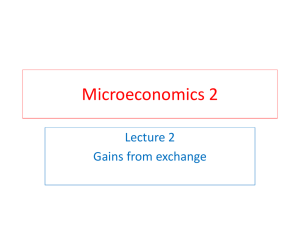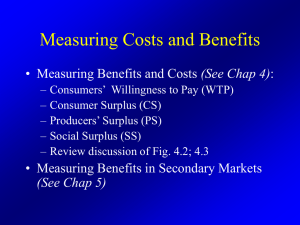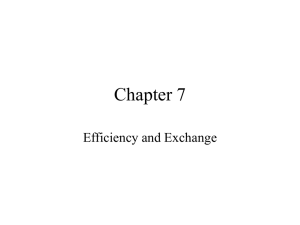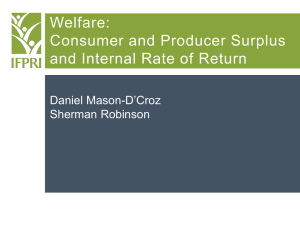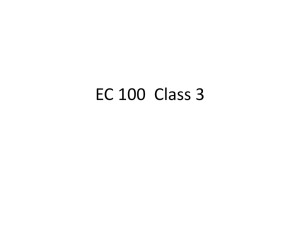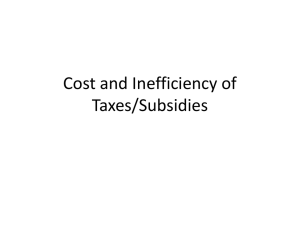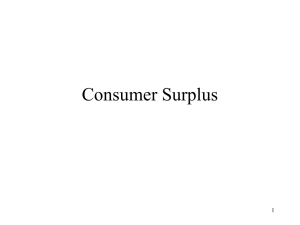Lecture_note_chapter_7_welfare economics
advertisement
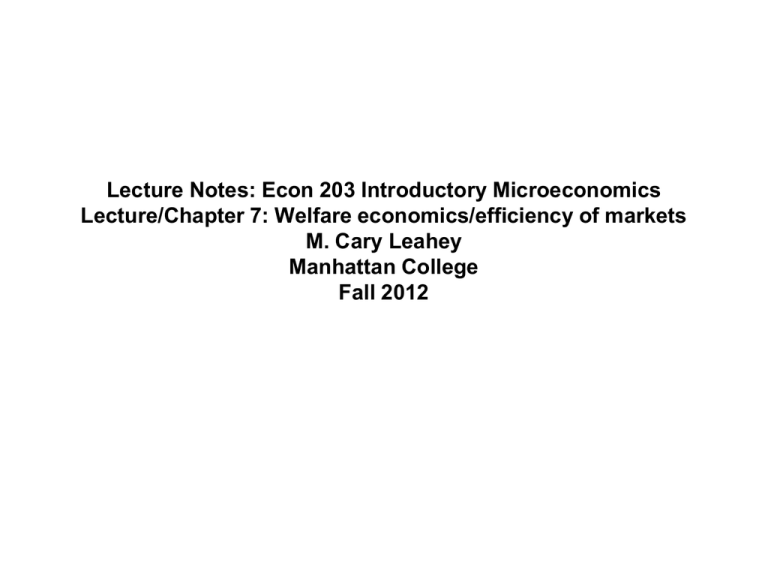
Lecture Notes: Econ 203 Introductory Microeconomics Lecture/Chapter 7: Welfare economics/efficiency of markets M. Cary Leahey Manhattan College Fall 2012 Goals • Introduction of welfare economics, how the allocation of resources affects economic well-being • Introduce useful policy concepts: • consumer surplus • producer surplus • willingness to pay • when the govt can help/hurt market outcomes 2 Well being of consumers-willingness to pay • Willingness to pay (WTP) is how much a buyer is the maximum amount a buyer is willing to pay for a good or service • WTP is a direct measure of consumer valuation • A demand curve can be derived by determining the WTP of each individual in the survey (next slide) • Moving perfectly along this WTP is the goal of every supplier, as we will be when we study monopoly pricing 3 WTP and the demand curve, as the number of number increases the “staircase” becomes a smooth curve P $350 $300 P Qd $250 $200 $301 & up 0 251 – 300 1 $150 176 – 250 2 $100 $50 126 – 175 3 0 – 125 4 $0 Q 0 1 2 3 4 Consumer surplus (CS) Consumer surplus is the amount a buyer is willing to pay minus the amount the buyer actually pays: CS = WTP – P name Anthony WTP $250 Suppose P = $260. Flea’s CS = $300 – 260 = $40. Chad 175 Flea 300 The others get no CS because they do not buy an iPod at this price. John 125 Total CS = $40. Consumer surplus and the “staircase” demand curve P Flea’s WTP $350 $300 Anthony’s WTP $250 $200 Instead, suppose P = $220 Flea’s CS = $300 – 220 = $80 Anthony’s CS = $250 – 220 = $30 $150 Total CS = $110 $100 $50 $0 Q 0 1 2 3 4 How a higher price reduces consumer surplus If P rises to $40, CS = ½ x 10 x $20 = $100. Two reasons for the fall in CS. 2. Fall in CS due to remaining buyers paying higher P P 60 50 1. Fall in CS due to buyers leaving market 40 30 20 10 D Q 0 0 5 10 15 20 25 30 Cost and the supply curve (producers surplus) • Cost is the value of everything (all-in) the producer must give up to produce a good (opportunity cost) • Includes all resource costs of input, including the opportunity cost of the seller’s time • See chart of a stepwise supply curve 8 Cost and the supply curve P P $40 Qs $0 – 9 0 10 – 19 1 $20 20 – 34 2 $10 35 & up 3 $30 $0 Q 0 1 2 3 Producer surplus PS = P – cost P $40 Producer surplus (PS): the amount a seller is paid for a good minus the seller’s cost $30 $20 $10 $0 Q 0 1 2 3 Producer surplus and the S curve PS = P – cost P $40 Chrissy’s cost $30 Janet’s cost $20 Jack’s cost $10 $0 Q 0 1 2 3 Suppose P = $25. Jack’s PS = $15 Janet’s PS = $5 Chrissy’s PS = $0 Total PS = $20 Total PS equals the area above the supply curve under the price, from 0 to Q. Producer surplus with lots of sellers and a smooth S curve PS is the area b/w P and the S curve, from 0 to Q. 60 The height of this triangle is $40 – 15 = $25. 50 So, PS = ½ x b x h = ½ x 25 x $25 = $312.50 P The supply of shoes S 40 30 h 20 10 Q 0 0 5 10 15 20 25 30 How a lower price reduces producer surplus If P falls to $30, P PS = ½ x 15 x $15 = $112.50 60 Two reasons for the fall in PS. 50 1. Fall in PS due to sellers leaving market S 40 30 2. Fall in PS due to remaining sellers getting lower P 20 10 Q 0 0 5 10 15 20 25 30 Total surplus = consumer plus producer surplus • Consumer surplus is the value to buyers • The buyers gains from participating in the market • Producer surplus is the value to seller = amount received less costs • The sellers gain from participating in the market. • Total surplus = CS + PS • Total gains from trade • Value to buyers – cost to sellers 14 Market allocation of resources – efficiency versus equity • In the market economy, allocation of resources is conducted by decentralized atomistic buyers and sellers • Is the market outcome desirable? Would another be better? • The economist’s answer is to look at the total surplus as a measure of societal well-being to see if the result is efficient. The question of equity is usually reserved fro another day. 15 Efficiency • The market allocation is efficient if it maximizes total surplus • Goods are consumed by the buyers who value them most highly (movement down the demand curve). • Goods are produced by the producers with the lowest costs (movement up the supply curve). • Changing quantity would not increase total surplus. 16 Evaluating the market equilibrium P Market equilibrium: P = $30 Q = 15,000 Total surplus = CS + PS Is the market equilibrium efficient? 60 S 50 40 CS 30 PS 20 10 D Q 0 0 5 10 15 20 25 30 Which buyers consume the good? Every buyer whose WTP is ≥ $30 will buy. Every buyer whose WTP is < $30 will not. So, the buyers who value the good most highly are the ones who consume it. P 60 S 50 40 30 20 10 D Q 0 0 5 10 15 20 25 30 Which sellers produce the good? Every seller whose cost is ≤ $30 will produce the good. Every seller whose cost is > $30 will not. So, the sellers with the lowest cost produce the good. P 60 S 50 40 30 20 10 D Q 0 0 5 10 15 20 25 30 Does equilibrium Q maximize total surplus? At Q = 20, cost of producing the marginal unit is $35 value to consumers of the marginal unit is only $20 Hence, can increase total surplus by reducing Q. This is true at any Q greater than 15. P 60 S 50 40 30 20 10 D Q 0 0 5 10 15 20 25 30 Does equilibrium Q maximize total surplus? At Q = 10, cost of producing the marginal unit is $25 value to consumers of the marginal unit is $40 Hence, can increase total surplus by increasing Q. This is true at any Q less than 15. P 60 S 50 40 30 20 10 D Q 0 0 5 10 15 20 25 30 Does equilibrium Q maximize total surplus—invisible hand? P The market equilibrium quantity maximizes total surplus: At any other quantity, can increase total surplus by moving toward the market equilibrium quantity. This is Adam Smith’s “invisible hand.” 60 S 50 40 30 20 10 D Q 0 0 5 10 15 20 25 30 Free market versus intervention or central planning • By virtual definition, the market equilibrium is efficient and no change by the govt. cannot improve the market allocation • One expression “not touching the invisible hand” is laissez-faire. • Central planning cannot improve it because no one person or agency can effectively absorb and use all the information the market can process. • Example: Russians got in lines for goods not knowing what they were in line for, thinking if there was a line, it must be worth waiting for! 23 Summary • Another principle fleshed out using welfare economics– market (under certain restrictions) are pretty good at organizing economic activity (efficiency). • Distribution can be another story (equity). • Modifying these restrictions can invalidate the efficiency outcome. • Market failures occur: • when one buyer has market power (monopoly) • transactions have side effects-externalities (pollution) • Buzzwords – invisible hand/laissez faire 24 SUMMARY • The height of the D curve reflects the value of the good to buyers— • • • • • their willingness to pay for it. Consumer surplus is the difference between what buyers are willing to pay for a good and what they actually pay. On the graph, consumer surplus is the area between P and the D curve. The height of the S curve is sellers’ cost of producing the good. Sellers are willing to sell if the price they get is at least as high as their cost. Producer surplus is the difference between what sellers receive for a good and their cost of producing it. On the graph, producer surplus is the area between P and the S curve. SUMMARY • To measure society’s well-being, we use total surplus, the sum of consumer and producer surplus. • Efficiency means that total surplus is maximized, that the goods are produced by sellers with lowest cost, and that they are consumed by buyers who most value them. • Under perfect competition, the market outcome is efficient. Altering it would reduce total surplus.


